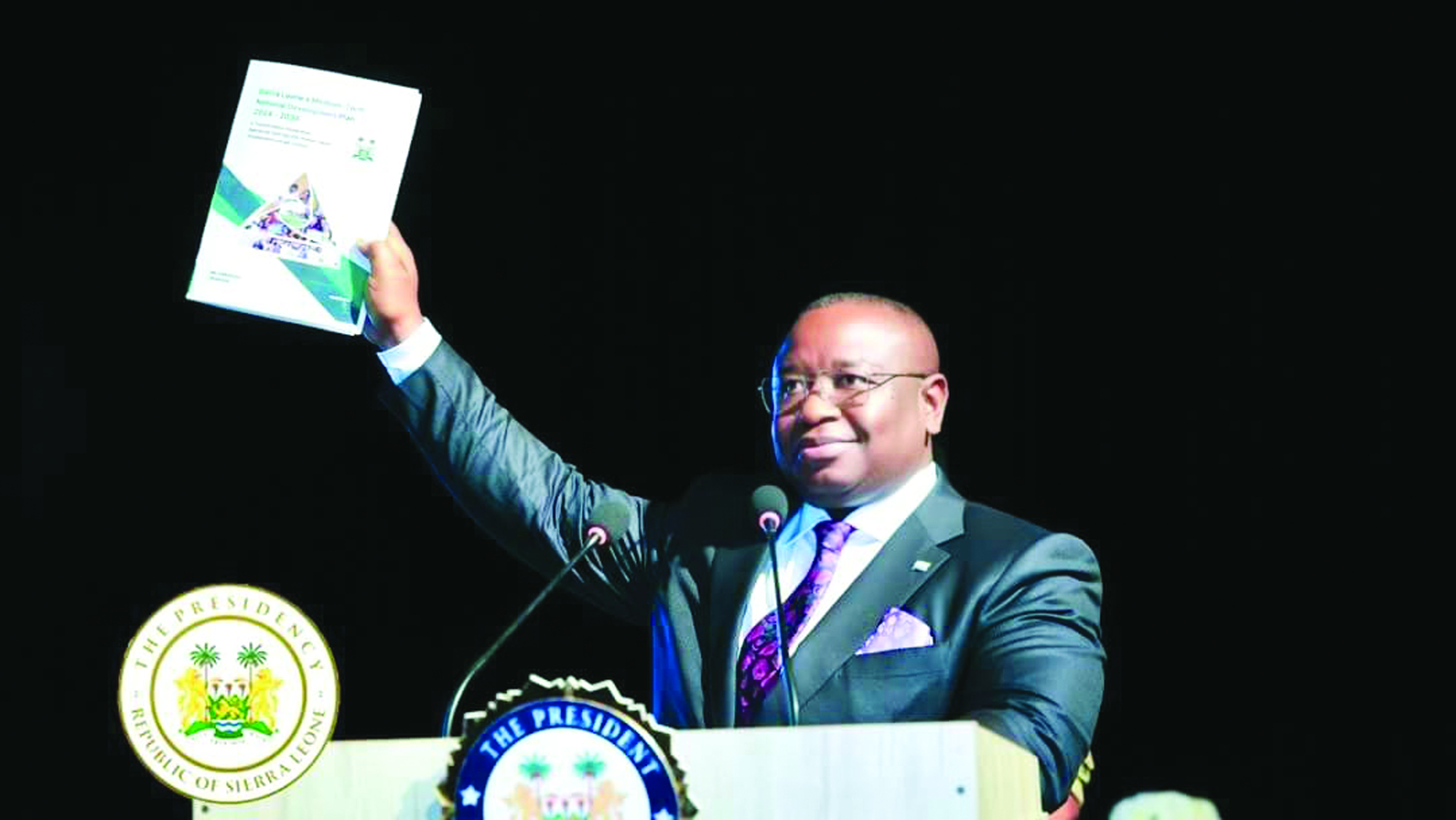As the economy-destroying global COVID-19 pandemic was winding down late in 2022, Sierra Leone, like many countries, was reeling from its after-effects, and they were exceptionally harrowing, owing to the country’s peculiar status as a post-conflict economy that was on the mend before the pandemic struck.
As if the climate and COVID-related problems were not enough, Russia’s invasion of Ukraine early that year exacerbated macroeconomic vulnerabilities the country was already battling to ease. Inflation soared to 50 percent in August from 21 percent at the same period the year before, while GDP dropped from 4.1 percent to about 2.8 percent, according to the African Development Bank statistics. Rising global energy, food, and fertilizer prices resulting from the conflict caused fiscal imbalances that challenged the President Julius Maada Bio-led administration.
Swift Response
The president’s response was swift. He encouraged greater private sector participation in agriculture to reduce dependence on subsidies and imports and tightened fiscal discipline to bring down deficits and debt. He also harped on the need for more diversification of the economy from mineral exploitation, especially iron ore and diamonds, as well as more effort to strengthen the weak export sector.
The tough measures and hard work paid off at the general elections in June 2023, when President Bio won a second term mandate from the country’s appreciative voters. By end-2023, inflation had trended downward to below 30 percent.
What is more, things have started looking up for the beleaguered country as President Bio has been able to build bridges across the world, enabling Sierra Leone to resume fruitful relations with development partners while sprucing up its own home-grown development blueprint and road map.
Medium-Term National Development Plan 2024–2030
Sierra Leone’s Medium-Term National Development Plan 2024-2030, MTNDP 2024-2030, in the words of President Bio, is “a well-thought-out National Development Plan that serves as the backbone of (our) society, ensuring that the aspirations of (our) people are not only heard but also meticulously addressed.”
Inaugurated right on time on January 30, this year, the plan’s prompt preparation and delivery are indicative of the seriousness with which the government intends to handle the nation’s economic affairs going forward. Not that its precursor, which lapsed in 2023, was not moving the nation as desired; in fact, the idea was to let the new plan run alongside the old for a seamless transition. It means the Sierra Leone People’s Party (SLPP) Government would rejig and update the winning New Direction Agenda that carried it through President Bio’s first tenure in office as the country’s democratically elected leader. Bio himself confirmed that “in doing this, there is continuity, as the new plan builds on the achievements of the previous development plan and tackles unfinished business and emerging challenges with renewed vigor.”
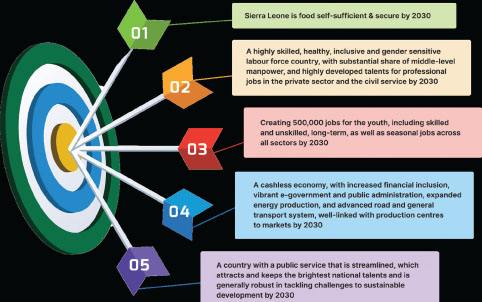
Big Five Game Changers
The new Medium-Term National Development Plan (MTNDP) is fashioned out of a strategic mix of national desiderata, quaintly named the Big Five Game Changers. These actually define the strategic priorities of Sierra Leone and its people for the next five to seven years. The five priorities and the lofty goals they are primed to achieve are as follows:
l Feed Salone: focused on boosting agricultural productivity and ensuring food security, aimed at enabling the country to achieve food self-sufficiency;
l Human Capital Development: aimed at delivering inclusive skills and a healthy population renowned for creativity and a capable labour force;
l Youth Employmnt Scheme: serves as a catalyst for social, democratic, economic, and national security, robust enough to create 500, 000 fresh jobs.
l Technology and Infrastructure: to increase investment in these critical areas and thus enhance national productivity, the objective is to expand energy production and develop an advanced transport system that seamlessly connects production centres to markets.
l Transforming the Public Service Architecture: to ensure efficiency and professionalism in the public sector well-adjusted to e-government and a public administration system that thrives on efficiency and innovation.
At a glance, it is easy to see that the grand aim of these goals is to achieve the Sustainable Development Goals (SDGs) by 2030, the medium-term aspiration of an inclusive, green, middle-income country by 2039, and the longer-term continental goal, the Africa We Want, by 2063. Then the inquisitive observer of the resilient West African country would be able to understand the rationale for the rather ponderous title chosen for this strategic document: A TRANSFORMATIVE ACCELERATION AGENDA FOR FOOD SECURITY, HUMAN CAPITAL DEVELOPMENT AND JOB CREATION.
Road to 2030 ….
On the road to 2030, the government of President Bio has figured out a way to make its flagship programme, Feed Salone, the success needed to give a fillip to the other game changers on the seminal New Development Plan. Committed to accelerating productivity and commercialization of the agricultural sector, care will be taken to plow investments into districts with the highest potential for success and growth by leveraging each district’s comparative advantage while also introducing synergistic value chains. More importantly, it is working on a blended financing model where the government combines its own resources with private capital.
Essentially, six strategic pillars undergird the Feed Salone strategy, starting with mechanisation and irrigation to expand rice production in all areas where the basic crop is grown. Next, improved, high-yielding seeds will continue to be sought through research and selection. Nor would the government neglect the vital issue of introducing and encouraging modern processing and marketing strategies to ensure profitability worthy of the effort investors put into the programmme.
Agricultural finance—tailoring financial instruments and solutions for the sector’s unique needs—is another problem that the Sierra Leonean authorities are dealing with to keep interest in farming alive. This is being facilitated through climate-smart agriculture by leveraging technology, supporting agricultural research, and building robust data systems as guides for decisions to follow. And finally, there will be an emphasis on the empowerment of women and youths by ensuring their indispensable role in agricultural development is reflected and elevated across all strategic pillars.
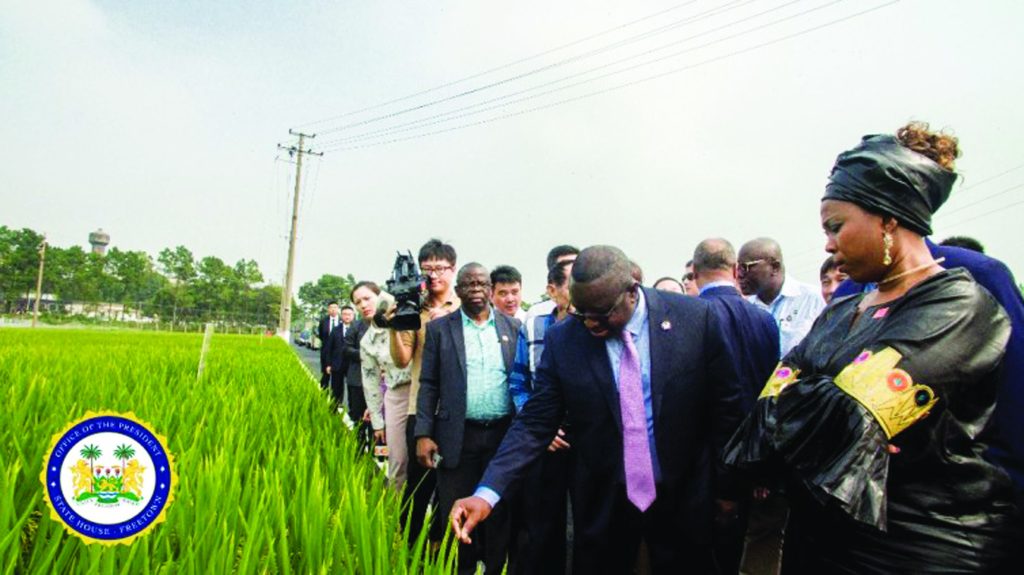
Projections…
Sierra Leone’s forward-looking government has made projections of the results it hopes to achieve at the close of the development plan period based on the reforms and revolutionary measures it is putting in place to drive the process.
Rice, by far the country’s staple, is expected to more than double yield tonnage from the 1.9 metric tonnes (MT) recorded last year to 4.0 MT by end-2028. Key staples such as rice, poultry, flour, and onions, which currently gulp about US$500 million in imports per year, should not take more than US$67 million by 2030.
Since the country is blessed with marine resources, the fisheries sub-sector is also being reformed for better operations and productivity. Industrial catch, now at 122 000 MT, should pass the 150 000 MT mark, while current annual revenues of NLe 105 million should soar to NLe 150 million.
The government also forecasts that citizens will have access to better and more nutritious food. Key human development statistics in this regard look to be a lot more impressive. The number of stunted children as a percentage of the total is estimated to improve from this year’s 23% to 9%; underweight children under the age of 5 years, now chalked up at 11%, is projected to trend down to 6.6%; and wasting due to inadequate and poor nutrition should retreat from 5.2% of the total to 3.1%.
The objective, as the authorities insist, is to build a nation with healthier, stronger people able to survive and thrive in the increasingly competitive global economy. As Sheku Ahmed Fantamadi Bangura, Sierra Leone’s Minister of Finance, who superintends these elements of economic and fiscal policies, notes, the state’s overall concern is the welfare of the people. The Bio administration has tactically shifted from the focus on human capital development in its first tenure to the more down-to-earth priority of food-self-sufficiency. Sierra Leone is being primed to fulfill the enormous potential it has in human and material resources, using its own people.
Motivating people for productivity
As far as President Bio is concerned, the current plan builds on the achievements of the outgoing one, as it constitutes a frontier shift from his administration’s human capital development (HCD) flagship programme during the previous plan 2019–2023. The new plan, he says, “builds on gains made in the implementation of its predecessor during the first term of my administration. It addresses unfinished business and emerging challenges.”
Little wonder then that Human Capital Development comes right after “Feed Salone” on the priority table. Starting with the upgrade of schools at the lower and middle levels, the government of Sierra Leone has its eyes on where the country’s children should be and how well the education system supports their aspirations, especially with respect to the needs of the labour market at the dawn of the 21st century.
The Free Quality Basic and Senior Secondary Education programme is being improved to standards compatible with the best in the sub-region. More attention is being paid to the instruction of children with special needs, while the general level of attendance, curriculum, and instruction across the board are under review.
By 2030, the authorities hope that the pupil-to-qualified teacher ratio will have significantly dropped from 63:1 to 43:11. This, of course, means massive investment in physical infrastructure as well as the training of instructors.
Serious reform and fresh policy work are also going on at the tertiary and higher institution levels. The plan envisages the enrolment of students in this level rising from 101,645 in 2023 to 171,645 by its expiration date. More significantly, the number of students accessing the student’s loans should jump from today’s modest 168 to a whopping 100, 000 beneficiaries, with at least 30% being female, by 2030. Not done, the administration forecasts that as many as 20, 000 young people would have been empowered by the Technical and Vocational Education and Training (TVET) skills acquisition programme.
Subscribing to the age-old health is wealth dictum, the government is bullish on “building a resilient and responsive health care system that provides equitable access to affordable quality healthcare services to all Sierra Leoneans across the life stages.” It hopes to improve life expectancy for the average Sierra Leonean from 54 to 65 years by the new plan’s close.
Such important statistics as the maternal mortality rate are projected to improve by 50% from 443 deaths per 100,000 live births to 219, while infant mortality should scale down by 50% as well, from 75 deaths per 1,000 live births to 38 deaths.
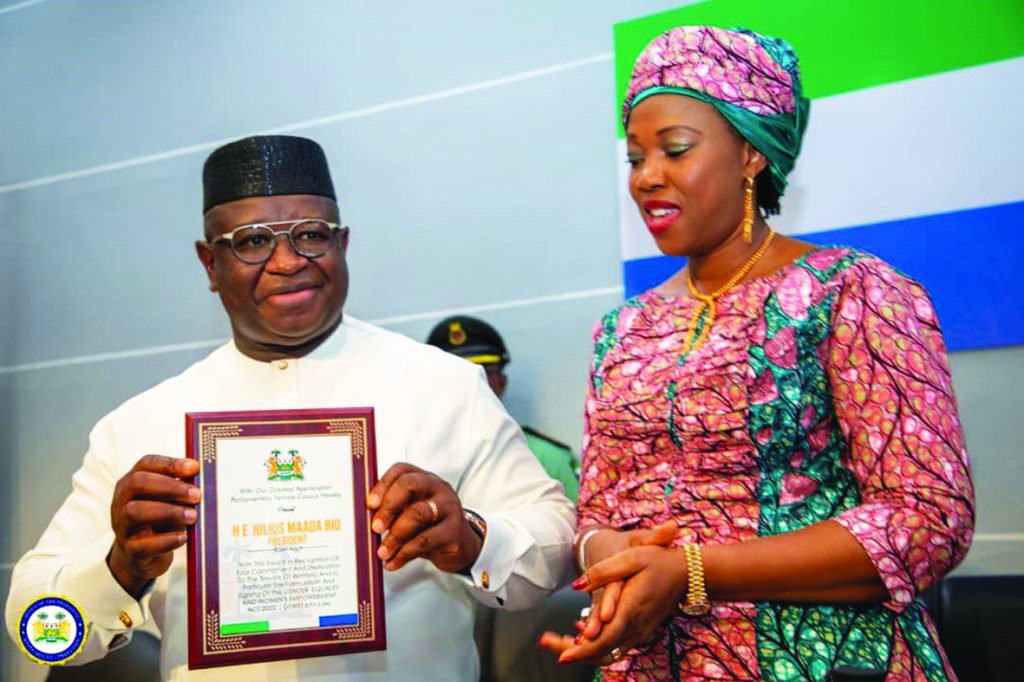
Power to the women…
Sierra Leone’s gender equality credentials mean a lot to President Bio. He thinks it is really absurd to neglect the needs and welfare of a good half of the country’s population. This modernist mindset shows through in the government’s care to include special affirmative action policies favouring the female folk in all spheres of the economy, down to the education of the girl child. The country hopes to decrease incidents of adolescent pregnancy from 21% to 10%.
The MTNDP categorically states the government’s commitment to consolidate and promote the gains from the state’s investment in advancing the empowerment of women in the political, social, economic, and cultural spheres, beginning with the contentious problem of women’s access to credit and financial inclusion in general. The state now runs a slew of policies that enable and encourage women entrepreneurs to access small-to-medium-term funds.
In his first term, President Bio’s administration elevated gender parity and women’s empowerment to unprecedented levels in the country’s history. The enactment of the Gender Equality and Women’s Empowerment (GEWE) Bill has increased female representation in appointive positions and in Parliament. Gender mainstreaming will ensure effective ushering-in of gender issues into national, sectoral, and local policies, plans, budgets, and programmes in order to significantly narrow gender inequality.
The projection is that by 2028, women will constitute at least 30% of the membership in parliament, in ministerial positions, and in local council mayoral and chairperson positions; and by 2025, gender units will be well established in all line ministries. It is also projected that Gender-Based Violence Information Management Systems Plus (GBVIMS+) should be in place across the country’s 16 districts.
On the economic side, women’s access to financial services should have surged from 25% to 65% by 2030, making women full participants in Sierra Leone’s development march.
And the disabled too …
Persons with disabilities in developing countries are often given the short end of the stick in all matters of welfare, and Sierra Leone has been an exception, largely due to the challenges peculiar to such growing economies. That fact, fortunately, hasn’t stopped the country from contemplating the plight of people with disabilities and the need to bring them up to the socio-economic level of the rest of society.
The government has resolved to correct the administrative injustice by announcing policy measures to raise the number of disabled persons benefiting from such social welfare programmes as cash transfers by 20%.
For the elderly, there are initiatives to set up, in addition to inflation-responsive pensions, a suitable framework for their welfare through fruitful participation in service delivery and other social activities.
Taking the youths off the job queue
President Bio’s passion for the youths can best be expressed in his own words. “We envision a Sierra Leone that creates at least half a million new jobs for our youths by 2030, in both skilled and unskilled roles,” he declared without flinching or batting an eyelid while addressing the Parliament on the occasion of the MTNDP’s flag-off in January this year.
Perhaps, President Bio is not unmindful of his own early rise to power as a young military officer and his urge to contribute to the advancement of his fatherland. He now wants to give the young generation of today a pathway to such a lofty ideal. The three-time leader now believes that youth empowerment serves as a catalyst for social, democratic, economic, and national security.

Addressing the infrastructure deficit and the tech gap
Back in 2018, when President Bio’s Sierra Leone’s Peoples Party took control of government, electric power generation and supply were below 100 MW, with less than 50 MW coming from Bumbuna Hydro Electric Power Station in the north. Dodo in the east and Charlotte in the west produced 6 MW and 2 MW, respectively. Save for Makeni and Port Loko in the north, other parts of the country did not get stable power supplies.
Since the advent of the administration, driven as it were by its New Direction Agenda, significant improvements have been recorded in power supply to consumers. Many communities have been connected to the upgraded national grid. Installed capacity has gone from about 105 MW to 160 MW. Renewable energy capacity has also jumped by 25%. Official data show that electricity generation capacity rose 31% to 55 kWH, with transmission lines expanding much further than the 2018 network length of 740km. Towards 2030, the MTNDP foresees the percentage of the population with access to electricity increasing from 31% to 60%.
Transport infrastructure, such as roads and bridges, is stretching out each year. More than 300 km of new roads have been added to the network, reaching more remote areas of the country. None can fail to notice the new $270 million Freetown International Airport complex built in partnership with Summa, a Turkish construction group at Lungi.
Telecommunications
There are about 1.84 million users of the internet in Sierra Leone today. That is a little short of what is needed to spark the digital revolution for the level of development the country’s leaders envisage. The new plan speaks of “communications, technology, and innovation services that are affordable to ensure they are effectively integrated into all development initiatives for growth, innovation, entrepreneurship, and building a digital economy.”
The figures break down to the following: the number of internet users is expected to increase by 63% from 1.84 million in 2023 to 2.9 million by 2030, and the Internet penetration rate is projected to increase from 21.2% in 2023 to at least 50% by 2030. These targets are compatible with a country that wants to see access to digital financial services increase from 32% in 2021 to 60% by 2030.
The implementation challenge
All economic actors and analysts, including President Bio himself, know that the implementation of even the best laid-out plans is a big challenge for policymakers and administrators. The Sierra Leonean leader has no trouble acknowledging this niggling fact. He says, “As we embark on this transformative journey, we acknowledge the vital importance of innovative financing in overcoming infrastructure challenges. We aim to find creative solutions and build strategic partnerships with various allies to achieve this goal.”
To set off on the right track, the MTNDP lists some “Enablers” of the implementation phase. They include: Financing, Partnerships for Implementation and Risks management, which cover the challenge of funding the plan; and how to settle the contentious but strategic issues of governance and accountability in well-defined clusters.
Funding the MTNDP
Cost of the plan and financing gap
The total projected cost of the seven-year New MTNDP 2024–2030 is US$12.05 billion. Of this amount, the sum of US$6.62 billion represents direct project-related costs, while the sum of US$5.43 billion represents the government’s statutory expenditures to support project implementation. The government has projected to raise US$9.49 billion from both internal and already committed external resources, leaving a total financing gap of US$2.56 billion for seven years (a US$366 million average annual gap), for which new money will be sought to fully finance the New National Development Plan.
The US$366 million annual gap for the new plan compares very well with the annual gap of US$310 million for the previous five-year plan, which had a total gap of US$1.55 billion. Essentially, the new plan is highly realistic of the need to ensure increased prudence in the management of state resources in the next seven years, given the challenging fiscal situation that both global and national economies will continue to encounter. The government will implement a robust integrated national financing framework to mobilize the needed resources, including innovative, climate, and blended financing.
There will be intentional rationalization of projects in the Public Investment Programme (PIP) system and the flagship programme within the Big Five Game Changers and their enablers to ensure that all project and programme outcomes and outputs positively impact growth, development, and job creation.
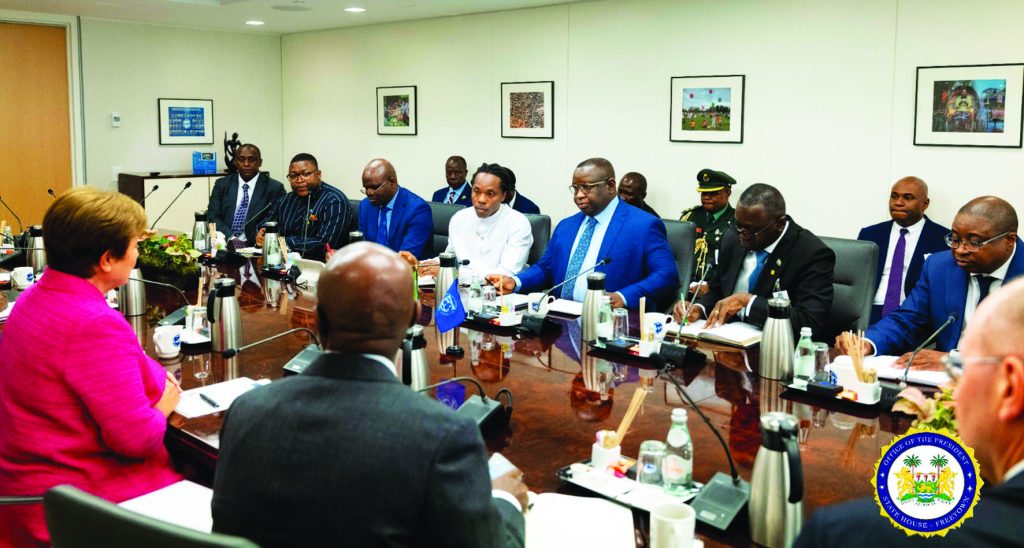
Relations with development partners
For development assistance, a strategic objective is to encourage joint programming and division of labour among donor agencies to reduce fragmentation and duplication of activities.
With respect to NGO operations, the strategic objective will be to scale up the coordination of operations of these organisations through increased information management on their activities, hold regular coordination meetings at national, sectoral, and district levels, and build operational capacity, including training of NGO Desk Officers across sectors and districts.
A recent collaboration with the United Nations Development Programme (UNDP) concluded the following studies and assessments within the country’s Integrated National Financing Framework (INFF):
n Study on barriers and enablers of women’s participation in domestic resource mobilization in Sierra Leone;
n A study on Diaspora investment potential in Sierra Leone; and
n An SDG investor mapping to identify and propagate market incentives and signals for private investment. Once these studies have been launched, it will be critical to develop and implement projects to scale up financing for the SDGs in the country.
Strengthening external relations and Economic Diplomacy
The Government of Sierra Leone is promoting socio-political, economic, and strategic interests to ensure quality representation in foreign missions, as well as increased foreign direct investments (FDIs) and partnership opportunities.
It is strengthening relations and increasing visibility within the Economic Community of West African States (ECOWAS) and the Mano River Union (MRU), while facilitating Sierra Leone’s participation in addressing sub-regional stability and sustainable development.
Drive for Foreign Investments
President Bio recognises the fact that attracting and fostering investments is essential for driving Sierra Leone’s growth and development. This explains why he has consistently reiterated the country’s unique offerings to investors, pledging government’s commitment to creating an enabling environment for Foreign Direct Investments (FDIs).
He used the opportunity of the recent Sierra Leone Investment Forum in Beijing, China to invite credible investors to leverage the plethora of opportunities in key growth sectors of Sierra Leone.
In October 2023, he addressed the Committee of Ambassadors from the Organisation of African, Caribbean and Pacific States (OACPS) on the sidelines of the Rebranding Africa Forum in Brussels, Belgium, making a strong case for Sierra Leone as one of Africa’s investment destinations.
President Bio’s foreign investment drive also led to the recent signing of a Memorandum of Understanding (MoU) on trade and investment between Sierra Leone and the United Kingdom.
Implementation Arrangements
Implementation of programmes in the medium-term national development plan is coordinated at national, regional, district, and community levels. Consequently, there will be a decentralized arrangement for the effective coordination of implementation, as in the previous plan.
The Ministry of Planning and Economic Development, under Ms Kenyeh Barlay, will continue to provide general operational leadership in the coordination of implementation across the different layers at national, sectoral, regional/district, and community levels.
Governance and Implementation
u Political Modernisation for Consolidating Peace and National Cohesion: Ensure a peaceful, united, and cohesive Sierra Leone where diversity, inclusion, transparency, accountability, and human rights are respected.
u Strengthening Legislations, Policies, and Practices in Fighting Corruption and Illicit Financial Flows: Reduce corruption significantly through the prevention, investigation, and prosecution of corruption in all its forms and scaling up the fight against illicit financial flows.
u Public Financial Management: Continue to ensure the prudent, efficient, effective, and transparent use of public funds.
u Audit Services: Support government institutions in improving revenue generation and service delivery to citizens by strengthening Sierra Leone’s independence and increasing its audit coverage when undertaking financial compliance and performance audits.
u Inclusive and Accountable Justice Institutions: Ensure that all citizens benefit from a fair, impartial, and effective justice sector by enabling increased access to justice, the expedition of justice, the protection of human rights, and equal opportunities for economic development.
u Public Trust in Institutions: Build trust in state institutions through the implementation of strategies to strengthen national cohesion and ensure a peaceful, just, and inclusive society.
u Decentralisation, Local Governance, and Rural Development: Strengthen local governance architecture, address staff retention deficiencies in local councils, enhance local food security, and promote local economic development.
u Security Institutions: Build an efficient, effective, highly apolitical, and professional security sector that can contribute significantly to sustainable development, the advancement of democracy, the rule of law, and a robust response to national threats and emergencies.
All about the people
The Minister for Economic Planning and Development, Barlay, readily knows the focus and new direction of the development plan: “We will place the people at the centre of financing for development more than ever, while scaling up sectoral coordination and public policy coherence, prioritisation and sequencing,” she assures. ”We will pursue a people’s planning process.”
The country’s touch-bearer and leader, President Julius Maada Bio, is eager to “breathe life into his people’s aspirations.” Like his cabinet ministers, he is bullish on “turning dreams into tangible achievements for (his beloved Sierra Leonean) people.”
“We envision this new National Development Plan will propel us towards our middle-income aspiration by 2039,” he says, bubbling with enthusiasm and optimism.
A hardcore pragmatist, President Bio, however, drops a much-needed ‘word of caution’: “Remember, the strength of our policies lies not in their conception but in their execution.”


